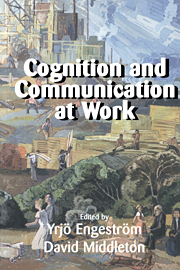Book contents
- Frontmatter
- Contents
- Contributors
- Acknowledgments
- 1 Introduction: Studying work as mindful practice
- 2 Distributed cognition in an airline cockpit
- 3 Constituting shared workspaces
- 4 Seeing as situated activity: Formulating planes
- 5 Convergent activities: Line control and passenger information on the London Underground
- 6 Users and designers in mutual activity: An analysis of cooperative activities in systems design
- 7 System disturbances as springboard for development of operators' expertise
- 8 Expert and novice differences in cognition and activity: A practical work activity
- 9 The tensions of judging: Handling cases of driving under the influence of alcohol in Finland and California
- 10 Talking work: Argument, common knowledge, and improvisation in teamwork
- 11 The collective construction of scientific genius
- 12 Experience and the collective nature of skill
- 13 Working together: Symbolic interactionism, activity theory, and information systems
- 14 On the ethnography of cooperative work
- Index
12 - Experience and the collective nature of skill
Published online by Cambridge University Press: 05 June 2012
- Frontmatter
- Contents
- Contributors
- Acknowledgments
- 1 Introduction: Studying work as mindful practice
- 2 Distributed cognition in an airline cockpit
- 3 Constituting shared workspaces
- 4 Seeing as situated activity: Formulating planes
- 5 Convergent activities: Line control and passenger information on the London Underground
- 6 Users and designers in mutual activity: An analysis of cooperative activities in systems design
- 7 System disturbances as springboard for development of operators' expertise
- 8 Expert and novice differences in cognition and activity: A practical work activity
- 9 The tensions of judging: Handling cases of driving under the influence of alcohol in Finland and California
- 10 Talking work: Argument, common knowledge, and improvisation in teamwork
- 11 The collective construction of scientific genius
- 12 Experience and the collective nature of skill
- 13 Working together: Symbolic interactionism, activity theory, and information systems
- 14 On the ethnography of cooperative work
- Index
Summary
Introduction
As information technology diffuses through manufacturing, an increasingly important question concerns the ways in which workers acquire and use skills in high-tech production (Cole, 1989; Brown, Reich, & Stern, 1991). In this chapter I explore skill formation in two advanced auto plants in Mexico: an engine plant and an assembly and stamping complex. The plants – at the cutting edge of a new international division of labor – provide an excellent context to observe the ways in which skills are formed and used. At their launch in the 1980s, the two factories brought together inexperienced though well-educated workers with some of the most advanced manufacturing technologies used anywhere in the world. People who had never been in a factory before had to grapple with operating and maintaining robots, computer-controlled machining lines, laser measuring systems, and a host of other advanced machines and computerized systems. Surprisingly, both plants enjoyed impressive success: in the space of several years they matched or surpassed the performance of comparable U.S. and even Japanese plants in critical areas such as quality.
My original purpose in undertaking these studies was to better define the mobility of advanced manufacturing in an age of computers and telecommunications, focusing on the tradeoffs between siting production in advanced industrial economies or newly industrializing countries (Shaiken & Herzenberg, 1987; Shaiken, 1990). I soon found, however, that this mobility was heavily dependent on the effectiveness with which workers could acquire new skills, especially the ability to maintain and quickly repair complex equipment.
- Type
- Chapter
- Information
- Cognition and Communication at Work , pp. 279 - 295Publisher: Cambridge University PressPrint publication year: 1996
- 4
- Cited by



